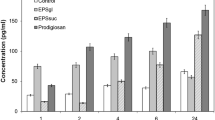Abstract
A delayed-type inflammatory response was evoked in mice using concanavalin A (Con A) as a stimulus, and the effect of various anti-inflammatory agents on the inflammations was examined. The intraperitoneal injection of Con A in the mouse resulted in the marked accumulation of leukocytes, especially macrophages, in the peritoneal cavity between 16 and 48 hr after the injection. Prior to the accumulation of macrophages, the chemotactic activity for macrophages appeared in the peritoneal fluid, and was associated with protein(s) in the molecular weight range from 10000 to 100000 daltons. When the effect of various agents on Con A-induced peritonitis was examined, neither anticomplementary agents (FUT-175 and K-76 COONa), bromophenacyl bromide, nordihydroguaiaretic acid nor indomethacin affected the generation of chemotactic activity and the accumulation of macrophages, suggesting that C5a, prostaglandins and leukotriene B4 are hardly involved in the Con A-induced macrophage accumulation. On the other hand, dexamethasone suppressed both the generation of chemotactic activity and the accumulation of macrophages. Taking into consideration the observation that the synthesis of macrophage chemotactic factors by mitogen-stimulated lymphocytes is inhibited by glucocorticoids these results suggest that the macrophage chemotactic lymphokines might be involved in the accumulation of macrophages in Con A-induced peritonitis.
Similar content being viewed by others
Abbreviations
- Con A:
-
concanavalin A
- NDGA:
-
nordihydroguaiaretic acid
- BPB:
-
bromophenacyl bromide
- DMSO:
-
dimethyl sulfoxide
- PBS:
-
phosphate-buffered saline
References
T. Yamashita, Y. Ishibashi, I. Nagaoka, K. Kasuya, K. Masuda, H. Warabi and Y. Shiokawa.Studies on glycogen-induced inflammation of mice. Dynamics of inflammatory responses and influence of anti-inflammatory drugs and protease inhibitors. Inflammation6, 87–101 (1982).
H. Z. Movat,The Inflammatory Reaction, pp. 311–336, Elsevier, Amsterdam 1985.
R. Snyderman, M. C. Pike, B.L. Blaylock and P. Weinstein,Effects of neoplasms on inflammation: depression of macrophage accumulation after tumor implantation. J. Immunol.116, 585–589 (1976).
I. Nagaoka, Y. Ishibashi and T. Yamashita,Studies on phytohemagglutinin-induced peritonitis of mice: dynamics of inflammatory responses and influence of anticomplementary agents and anti-inflammatory drugs. Int. J. Tiss. React.IX, 179–188 (1987).
T. Yamashita, N. Imaizumi and S. Yuasa,Effect of endocellular cryoprotectant upon polymorphonuclear neutrophil function during storage at low temperature. Cryobiology16, 112–117 (1979).
I. Nagaoka and T. Yamashita,Comparative studies on the leucine aminopeptidase activity of different types of leukocytes. Comp. Biochem. Physiol.79 B, 147–151 (1984).
H. Z. Movat,The Inflammatory Reaction, pp. 203–257 Elsevier, Amsterdam 1985.
P. A. Ward, T. E. Hugli and D. E. Chenoweth,Complement and chemotaxis. InChemical Messenger of the Inflammatory Process. (Ed. J. C. Houck) pp. 153–178, Elsevier, Amsterdam 1979.
S. H. Ferreira,Prostaglandins. InChemical Messengers of the Inflammatory Process. (Ed. J. C. Houck) pp. 113–151, Elsevier, Amsterdam 1979.
S. Fujii and Y. Hitomi,New synthetic inhibitors of Ctr, C1 esterase, thrombin, plasmin, kallikrein and trypsin. Biochim. Biophys. Acta661, 342–345 (1981).
K. Hong, T. Kinoshita, W. Miyazaki, T. Izawa and K. Inoue,An anti-complementary agent, K-76 monocarboxylic acid: its site and mechanism of inhibition of the complement activation cascade. J. Immunol.122, 2418–2423 (1979).
G. J. Blackwell and R. J. Flower,Inhibition of phospholipase. Br. Med. Bull.39, 260–264 (1983).
G. A. Higgs and J. R. Vane,Inhibition of cyclo-oxygenase and lipoxygenase. Br. Med. Bull.39, 265–270 (1983).
R. Snyderman, M. C. Pike, D. McCarley and L. Lang,Quantification of mouse macrophage chemotaxis in vitro: role of C5 for the production of chemotactic activity. Infect. Immun.11, 488–492 (1975).
M. J. H. Smith, A. W. Ford-Hutchinson and M. A. Bray,Leukotriene B: a potential mediator of inflammation. J. Pharm. Pharmacol.32, 517–518 (1980).
R. M. J. Palmer, R. J. Stepney, G. A. Higgs and K. E. Eakins,Chemokinetic activity of aracidonic acid lipoxygenase products on leucocytes of different species. Prostaglandins20, 411–418 (1980).
M. A. Bray,The pharmacology and pathophysiology of leukotriene B 4. Br. Med. Bull.39, 249–254 (1983).
P. A. Ward, H. G. Remold and J. R. David,Leukotactic factor produced by sensitized lymphocytes. Science163, 1079–1081 (1969).
R. Snyderman, L. C. Altman, M. S. Hausman and S. E. Mergenhagen,Human mononuclear leukocyte chemotaxis: a quantitative assay for humoral and cellular chemotactic factors. J. Immunol.108, 857–860 (1972).
L. C. Altman R. Snyderman, J. J. Oppenheim and S. E. Mergenhagen,A human mononuclear leukocyte chemotactic factor: characterization, specificity and kinetics of production by homologous leukocytes. J. Immunol.110, 801–810 (1973).
D. A. Boetcher and M. S. Meltzer,Mouse mononuclear cell chemotaxis: description of system. J. Natl. Cancer Inst.54, 795–799 (1975).
H. Rühl,Effects of L-asparaginase and hydrocortisone on human lymphocyte transformation and production of a mononuclear leucocyte chemotactic factor in vitro. Immunology26, 989–994 (1974).
S. M. Wahl, L. C. Altman and D. L. Rosenstreich,Inhibition of in vitro lymphokine synthesis by glucocorticosteroids. J. Immunol.115, 476–481 (1975).
R. E. Rocklin and J. R. David,Studies on the characterization of mediators produced by antigen-stimulated human lymphocytes. Fed. Proc.30, 395 (1971).
E. J. Leonard and M. S. Meltzer,Characterization of mouse lymphocyte-derived chemotactic factor. Cell Immunol.26, 200–210 (1976).
Author information
Authors and Affiliations
Rights and permissions
About this article
Cite this article
Nagaoka, I., Kaneko, H. & Yamashita, T. Inhibition of the accumulation of macrophages and the generation of macrophage chemotactic activity by dexamethasone in concanavalin A-induced peritonitis of mice. Agents and Actions 25, 156–163 (1988). https://doi.org/10.1007/BF01969107
Received:
Accepted:
Issue Date:
DOI: https://doi.org/10.1007/BF01969107



